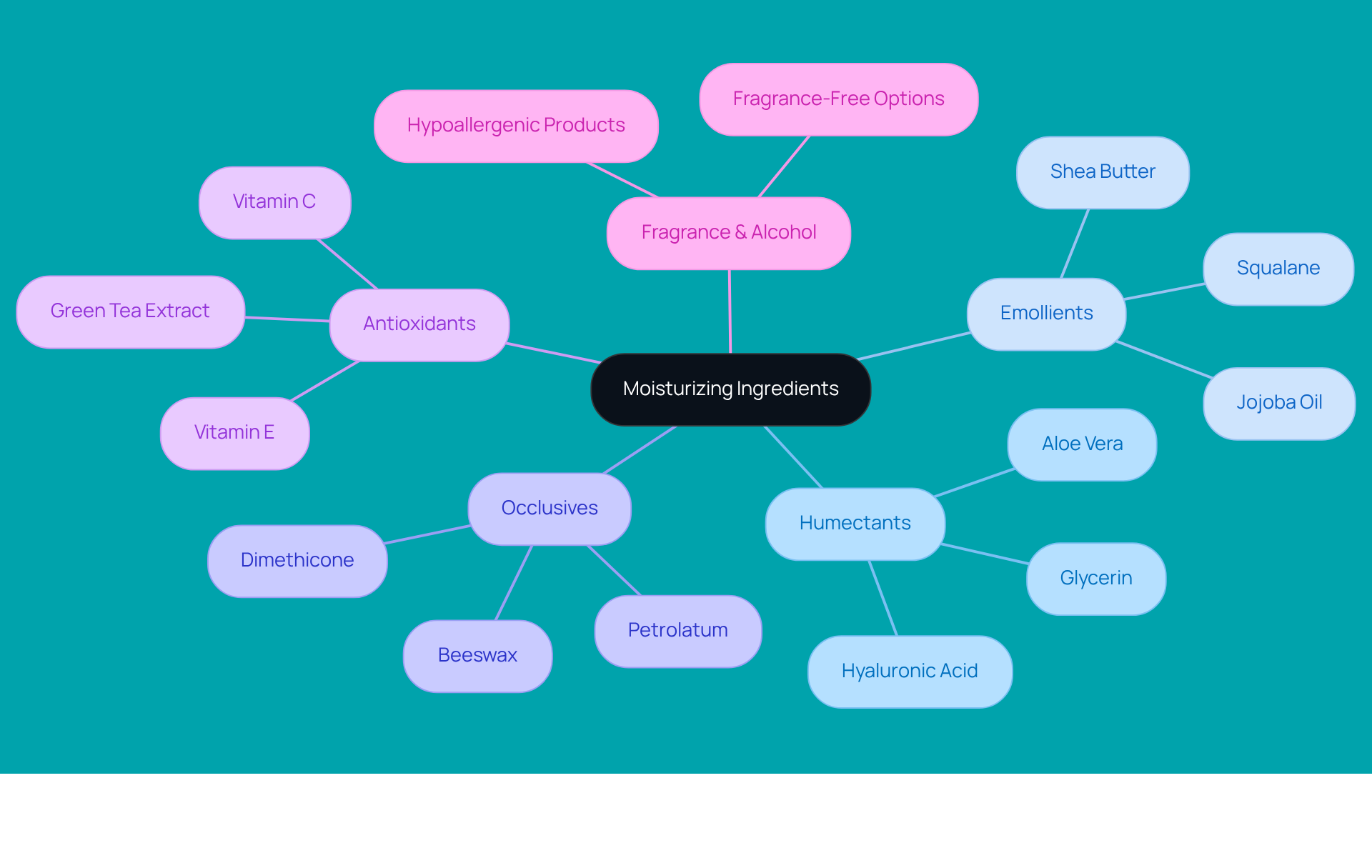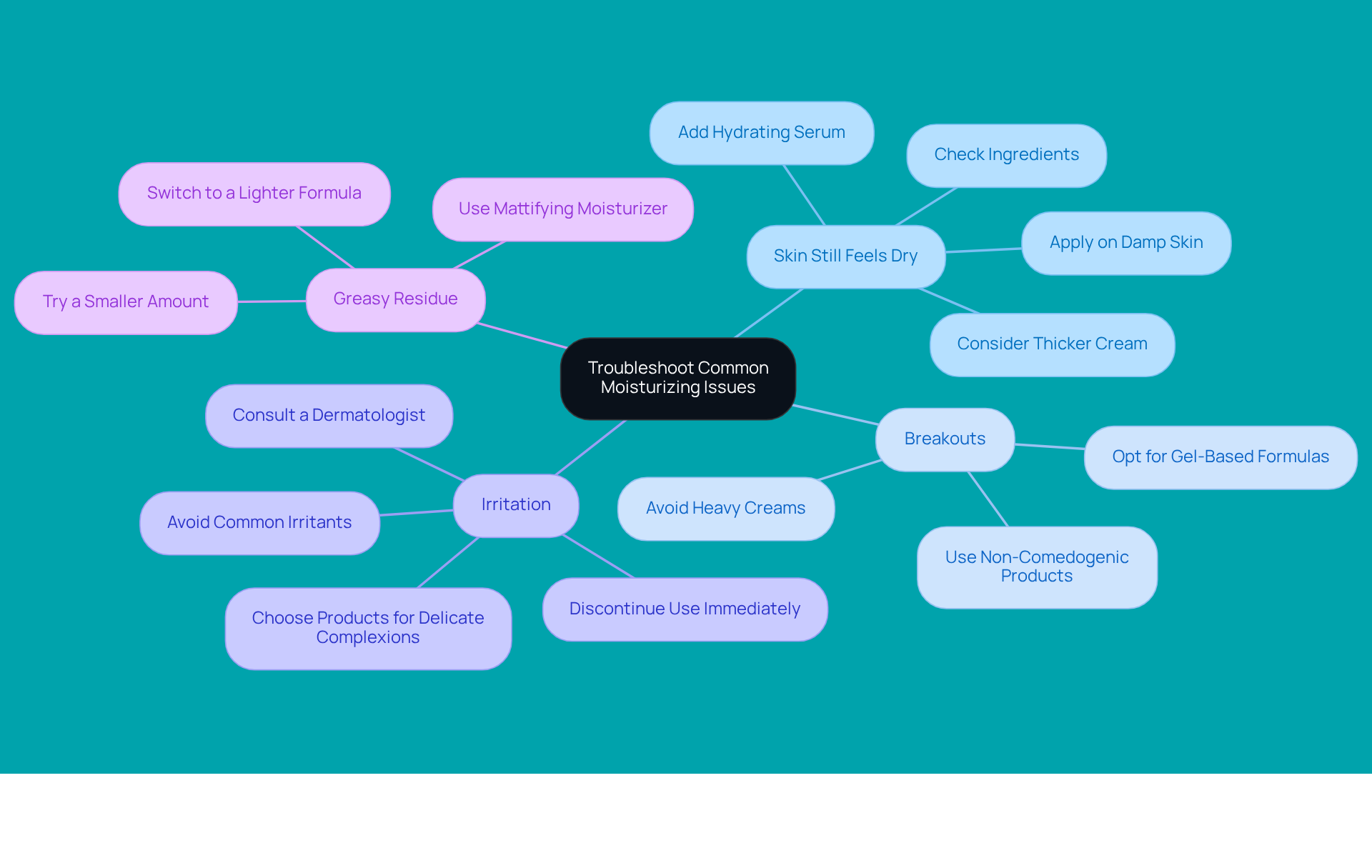Overview
The main focus of this article is to help health-conscious consumers like you effectively select body moisturizers that are tailored to your unique skin type and needs. We understand that navigating the world of skincare can be overwhelming, which is why we provide a comprehensive guide designed to empower you. This guide includes:
- Identifying your skin type
- Understanding beneficial ingredients
- Choosing the right product based on your lifestyle
- Troubleshooting common moisturizing issues
By addressing these aspects, we aim to equip you with the knowledge to make informed skincare choices that truly resonate with your personal journey.
Introduction
Finding the right body moisturizer can feel overwhelming for those of us who prioritize health and wellness, especially with so many options available today. It’s essential to understand your skin type, as this knowledge directly impacts how well moisturizing ingredients can work for you. You might be wondering, how can you navigate the complexities of skincare to make choices that genuinely benefit your skin?
In this article, we will explore important steps to help you select the perfect body moisturizer tailored to your unique needs, while also addressing common moisturizing challenges and providing effective solutions. Together, let’s embark on this journey towards healthier, happier skin.
Identify Your Skin Type
Identifying your is an important step in nurturing your complexion. Let’s walk through this together:
-
Cleanse Your Skin: Begin with a gentle cleanser to remove any makeup, dirt, or oils. After cleansing, pat your skin dry with a clean towel.
-
Wait for 30 Minutes: Allow your complexion to settle into its natural state without applying any products. This brief waiting period helps you observe how your skin reacts on its own.
-
Evaluate Your Complexion: After the 30 minutes, take a moment to inspect your skin in natural light. Look for these signs:
- Oily Skin: If your skin appears shiny, particularly on the forehead, nose, and chin (the T-zone), you may have oily skin.
- Dry Epidermis: If your skin feels tight, rough, or flaky, it could indicate a dry epidermis.
- Combination Type: If you notice oiliness in the T-zone but dryness on your cheeks, you likely have a combination [skin type](https://blog.itworks.com/understanding-ashwagandha-efectos-secundarios-you-should-know).
- Normal Complexion: If your skin feels balanced—not too oily or dry—you probably have a normal complexion.
- Sensitive Complexion: If your skin reacts easily to products, feels itchy, or shows redness, you may have a sensitive complexion.
-
Use Blotting Paper: For a more precise assessment, gently press blotting paper on different areas of your face. If the paper absorbs oil from the T-zone but not from the cheeks, it confirms a combination skin type.
By accurately identifying your skin type, you can select a that is tailored to your unique moisture needs. This thoughtful choice will enhance your overall , allowing you to feel confident and cared for in your skin journey.

Understand Moisturizing Ingredients
When selecting a , understanding the is essential. Imagine if you could choose a body moisturizer that effectively hydrates, nourishes, and protects your complexion. Let’s explore some important components together:
- Humectants: These wonderful ingredients draw moisture from the environment into your skin's surface. Common humectants like glycerin, hyaluronic acid, and aloe vera are perfect for all skin types, especially for those experiencing dryness.
- Emollients: These ingredients work to soften and smooth your skin by filling in gaps between cellular structures. Look for nourishing options like shea butter, jojoba oil, and squalane, which are particularly beneficial for dry and sensitive skin.
- Occlusives: These form a protective barrier on your skin to prevent . Ingredients such as petrolatum, beeswax, and dimethicone are effective occlusives, especially for extremely dry skin or during harsh weather.
- Antioxidants: Ingredients like vitamin E, vitamin C, and green tea extract help while enhancing overall dermal health. You might be wondering how these can make a difference—consider the long-term benefits they offer.
- Fragrance and Alcohol: It's wise to be cautious with products that contain added fragrances or high alcohol content, as these can irritate delicate skin. Whenever possible, .
By understanding these components, you can make informed choices about the best body moisturizer that aligns with your skin's needs. Together, let’s find a body moisturizer that truly supports your journey to .

Select the Right Moisturizer for Your Needs
can feel overwhelming, but it doesn’t have to be. Let’s walk through some thoughtful steps together to help you find the perfect match for your skin.
- Match Ingredients to Your Complexion Type: Understanding your complexion type is crucial. For example:
- Oily Skin: You might find that lightweight, oil-free moisturizers with gel-based formulas and ingredients like hyaluronic acid work wonders. These options maintain hydration without adding excess oil. Look for 'non-comedogenic' labels to keep your pores clear.
- Dryness: If you struggle with dryness, and occlusives like shea butter or petrolatum, which are excellent at retaining moisture. For those over 50, cream-based moisturizers can be particularly beneficial.
- Combination Complexion: A balanced lotion that hydrates without heaviness is ideal for you. Look for formulations that blend humectants and emollients.
- Sensitive Skin: Opt for fragrance-free, hypoallergenic choices, enriched with calming ingredients like aloe vera or chamomile to minimize irritation.
- Consider Your Lifestyle: Are you often outdoors? Prioritize . For nighttime, thicker creams can deeply hydrate while you sleep, addressing moisture loss that occurs overnight. Remember to to lock in that precious hydration.
- Test Before You Buy: Before committing, try the product on a small area of your body to ensure it agrees with your skin. Many brands offer samples or travel sizes, allowing you to see how the product interacts with your complexion before making a full-size purchase.
- Read Reviews and Recommendations: ! Look for products praised by dermatologists or trusted sources. Reviews from people with similar skin types can provide valuable insights into the effectiveness of a hydrating product.
By thoughtfully selecting a body moisturizer that aligns with your complexion type and lifestyle, you can enhance your skincare routine, leading to a healthier, more hydrated complexion. Remember, even those with oily skin need hydration to prevent excess oil production, making a hydrating product essential for everyone. As a Gundersen skincare specialist notes, , just before applying sunscreen. Together, let’s nurture your skin to achieve its best self.

Troubleshoot Common Moisturizing Issues
If you’re facing challenges with your , you’re not alone. Let’s explore some helpful troubleshooting tips together:
-
Skin Still Feels Dry After Application:
- Have you tried applying your moisturizer on damp skin? This can really help lock in moisture.
- It’s also worth checking the ingredients for dehydrating components like alcohol or fragrances.
- You might consider switching to a thicker cream or even underneath for an extra boost.
-
Breakouts After Using a New Moisturizer:
- If you’re experiencing breakouts, that won’t clog your pores.
- For those with oily or acne-prone skin, avoiding heavy creams is key; could be your best friends.
-
Irritation or Redness:
- If irritation occurs, it’s best to discontinue use immediately. Consulting a dermatologist is a wise step if the issue persists.
- Opt for products specifically designed for delicate complexions, steering clear of common irritants.
-
Greasy Residue:
- Does your moisturizer feel too heavy? Trying a smaller amount or switching to a lighter formula might make a difference.
- If you have an oily complexion, consider using a mattifying moisturizer for a more comfortable feel.
By addressing these common concerns, you can refine your moisturizing routine and ensure your skin stays healthy and hydrated. Remember, taking these steps is a part of your , and you deserve to feel confident in your .

Conclusion
Understanding how to select the right body moisturizer is essential for achieving healthy, hydrated skin. Imagine if you could transform your skincare routine by simply choosing the right product. This guide emphasizes the importance of:
- Identifying your skin type
- Comprehending the nourishing ingredients that can protect your complexion
- Selecting a moisturizer that truly meets your individual needs
By taking these thoughtful steps, you can enhance your skincare routine and foster a deeper connection with your skin.
You might be wondering how to identify your skin type. The article outlines a clear process for doing just that, including practical tips for evaluating your complexion and recognizing the characteristics of different skin types. It also delves into key moisturizing ingredients—humectants, emollients, occlusives, and antioxidants—that can significantly impact your skin health. Furthermore, it provides actionable advice on selecting the right product based on your lifestyle and skin concerns, as well as troubleshooting common moisturizing issues.
Ultimately, making informed choices about body moisturizers not only contributes to a radiant appearance but also supports your overall skin health. By prioritizing hydration and understanding the unique needs of your skin, you can cultivate a skincare regimen that empowers you to feel confident in your own skin. Embracing these practices will lead to healthier, more resilient skin, making it vital to invest time and thought into selecting the best body moisturizer for your personal needs. Together, let's embark on this journey to nurture and cherish your skin.
Frequently Asked Questions
Why is it important to identify your skin type?
Identifying your skin type is crucial for nurturing your complexion and selecting appropriate skincare products that meet your unique moisture needs.
What is the first step in identifying your skin type?
The first step is to cleanse your skin with a gentle cleanser to remove any makeup, dirt, or oils, and then pat your skin dry with a clean towel.
How long should you wait after cleansing your skin before evaluating it?
You should wait for 30 minutes to allow your complexion to settle into its natural state without applying any products.
What signs should you look for when evaluating your complexion?
Look for the following signs:
- Oily Skin: Shiny appearance, especially on the T-zone (forehead, nose, chin).
- Dry Epidermis: Tight, rough, or flaky skin.
- Combination Type: Oily T-zone with dryness on the cheeks.
- Normal Complexion: Balanced skin, not too oily or dry.
- Sensitive Complexion: Easily reacts to products, feels itchy, or shows redness.
How can blotting paper help in assessing skin type?
Blotting paper can provide a more precise assessment by absorbing oil from different areas of the face. If it absorbs oil from the T-zone but not from the cheeks, it confirms a combination skin type.
How does identifying your skin type benefit your skincare routine?
By accurately identifying your skin type, you can select a body moisturizer tailored to your skin's specific moisture needs, enhancing your overall skincare routine and boosting your confidence in your skin journey.




